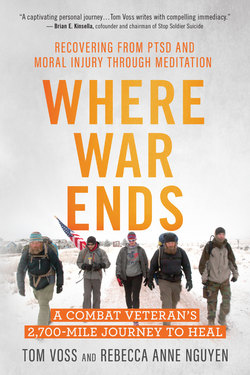Читать книгу Where War Ends - Tom Voss - Страница 11
На сайте Литреса книга снята с продажи.
ОглавлениеINTRODUCTION
From 2003 to 2006, I served on active duty in the US Army. In October 2004 I was deployed to Mosul, Iraq, to support Operation Iraqi Freedom. I served as an infantry scout in the battalion scout-sniper platoon in the 3rd Battalion, 21st Infantry Regiment, an element of the 1st Brigade 25th Infantry Division — one of the army’s first Stryker infantry brigades. During the twelve months I spent in Iraq, I participated in hundreds of combat missions, convoys, security patrols, raids, area-clearance operations, and humanitarian-relief operations. In 2006 I separated from the army with an honorable discharge.
And then I came home.
This book is about what happened next. It’s about the feelings I carried inside that no one, including me, talked about: feelings of grief, shame, guilt, and sorrow about the things I’d seen and done in Iraq. Those feelings didn’t change or go away, no matter what I tried. And I tried everything: talk therapy, EMDR, peer-support groups, alcohol, legal drugs, illegal drugs, you name it.
I decided to walk across the country because I had no other choice. I knew that if I didn’t take an extreme step to heal from trauma, the trauma I had experienced in Iraq would consume me and I would end my own life.
Walking across the country gave me the time and space I needed to heal. Walking was a way to convene with nature, which had always been a healing, uplifting force in my life. Some of my happiest childhood memories are of taking long walks in the forests and trails of northern Wisconsin. My dad taught my sister and me to respect the natural world and to view it with wonder. The wind in the trees, the deer hiding in the brush, the ripples on the surface of a still pond: all had something to teach us, if only we’d get quiet and listen. So I decided to walk from Milwaukee to Los Angeles to get back to that place — a place where the movement of my body on the outside made me still enough on the inside to learn the lessons nature had to teach me.
On that walk, nature became my healer and my teacher again. And like any good teacher, nature led me to other teachers — Native American healers, meditation instructors, and spiritual devotees. Nature even threw in a controversial Trappist monk and a world-renowned Indian guru for good measure.
It was about a month after I finished my 2,700-mile journey across America that I first learned about something called moral injury. This was the answer I’d been looking for — the cause of the symptoms I’d been battling for so long. Moral injury was the root of all the grief, shame, sorrow, and guilt I’d been feeling. It was a wound to the soul that had destroyed my sense of morality, demolished my moral architecture, and confused my moral place in society. Once I knew what had been causing those deep, emotional symptoms — what was beneath the depression and behind the anxiety — the healing process could truly begin.
During the five months I spent walking across the country, and in the years that followed, I’ve learned healing methods that I believe can help people who suffer from moral injury and extreme trauma. Meditation, yoga, and breath work have offered relief and healing I never could have imagined, both for me and for the other veterans I’ve worked with. I truly believe that if you’re willing to put in the time, these methods will work for you, too.
The end of my walk across America was just the beginning of a healing journey that I’m still on, and that I’ll continue on for the rest of my life. I hope that reading my story or watching my story in the documentary film Almost Sunrise will help you on your own journey to heal from moral injury. At the very least, I hope your sense of hope will be renewed by learning about someone who knows what it is to give up on life, and himself, completely.
It only takes a single flicker of light to cut through the darkness. And it only takes a single glimmer of hope to start healing from moral injury.
It’s my dream that this book will help you hang on to that sense of hope, no matter how small, with all your might.
You are not alone.
Healing is possible.
I’m living proof of that.
— Tom Voss
Ojai, California
October 2019
